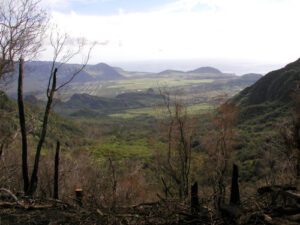In "Partner Perspectives" we get to know the diverse people, roles, and views of wildfire management in the Pacific. Amy Tsuneyoshi kindly spent some time with us her experience in protecting watershed forests, including post-fire management.
Name: Amy Tsuneyoshi
Role: Watershed Resource Specialist
Organization: Honolulu Board of Water Supply
Pacific Fire Exchange (PFX): Describe your role at the Board of Water Supply.
Amy (AT): My position is as a Watershed Resource Specialist. Our watershed program works with various partners across the island of Oahu to protect priority watershed areas for groundwater recharge. A lot of my time is spent in the office doing administrative activities - permitting and coordination between resources or groups to get things done on the ground. We work with a lot of different partners like the Koolau Mountains Watershed Partnership and Waianae Mountains Watershed Partnership (WMWP). Right now we’re working with WMWP to help establish vegetated fire breaks.
My background is in horticulture, and I always had an interest in native plants. At the time I started, “watershed” was just becoming the buzzword. I think as more interest and awareness of the importance of protecting the watershed grew, the BWS saw that need to be filled.
“It made me realize how many resources were being used to put out a fire that may or may not have been human-caused.”
PFX: What sparked your interest in wildfire?
AT: My first exposure to wildland fire was when I was in college. I worked for the US Forest Service for a summer in Washington. Towards the end of my internship, there were a lot of fires raging in Oregon. I was able to volunteer, work in several basecamps for the different fires, and assist the firefighters over the radio. Just having that interaction with them over the radio and seeing the tremendous effort they put in, and seeing the effort it takes to put the camp together - it stuck with me. It made me realize how many resources were being used to put out a fire that may or may not have been human-caused. With the position that I am in today, it helps me to appreciate the front-line people.
PFX: Can you give an example of partnership to meet a management goal?
AT: When I first started this position, the BWS and the State and some community groups formed the Waianae Kai Community Forest Project. In 2003, a couple months after we did a partner signing, there was a 7-acre fire that burned fairly-intact native forest on the ridge that separates Waianae and Makaha.
The BWS and DOFAW provided funds to help with restoration efforts. We were worried that we’d lose a lot of the topsoil, because nothing was holding it in place. We purchased soil erosion control materials, and along with volunteers from different agencies - Oahu Invasive Species Committee, Oahu Army Natural Resource program - we installed coconut core and straw waddle logs. A lot community volunteers came out as well - from the hunters association and UH Botany Department. We also out-planted some natives and did weed control over a couple years after the burn.
A lot of the koa canopy came back on it’s own. It’s not as diverse as it used to be, but the canopy is filling in. Work needs to be done in the understory now. We’d like to remove weeds that are underneath the canopy. There are native plants that are coming up too, like mamaki and naupaka, so there is a seed source there. I think the Waianae Partnership, along with some folks from the State as well as the Army, are looking at trying to improve the site.
PFX: What do you enjoy doing in your spare time?
AT: I like spending time outdoors and I enjoy gardening. I like to grow things that are edible and try to incorporate them into the landscape. I’m kind of running out of space in my yard! One thing I’m happy about right now is that my star fruit and acerola are finally fruiting.
PFX: What’s one thing most don’t know about you?
AT: I like to do arts and crafts. I paint and do knitting and crocheting and even tried wood-turning on a mini-lathe. When I knit and crochet I don’t do patterns, I just kind of do free-form things. The last things I made were these little weird-shaped squishy animals. After I make them I usually give them away.


